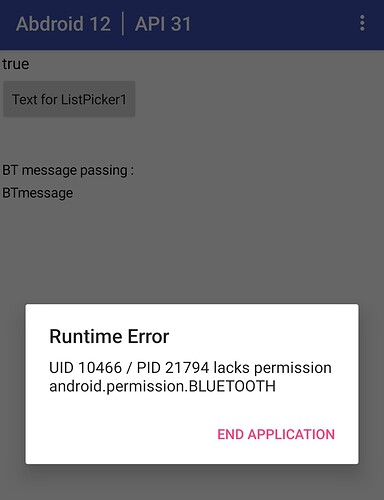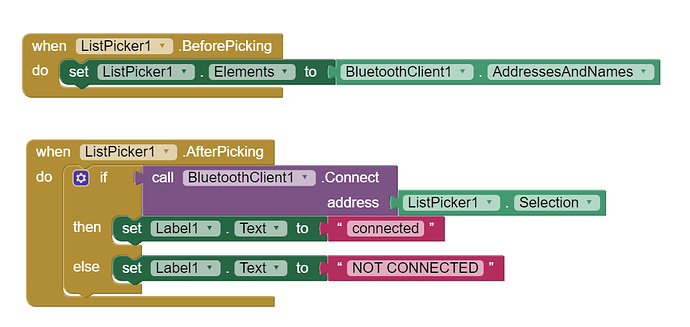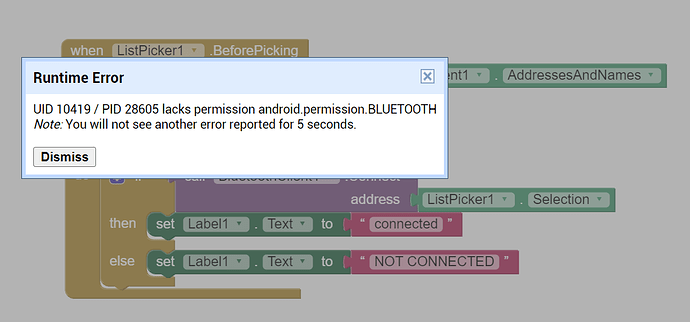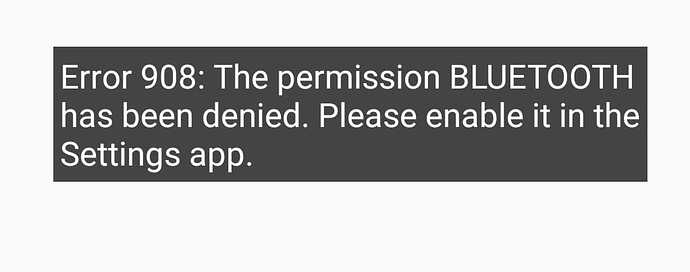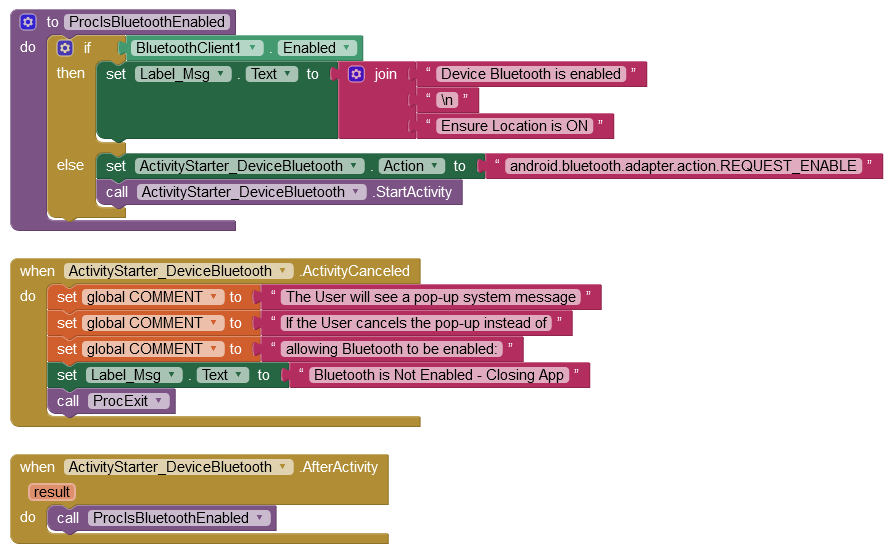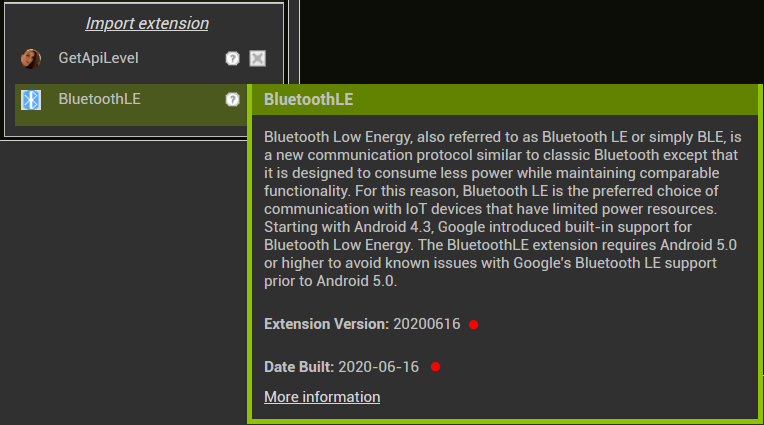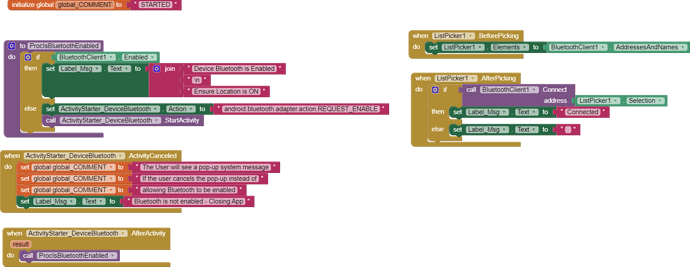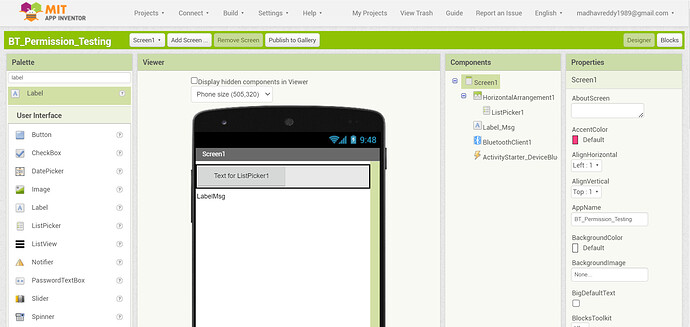

Hi all.
I'm currently facing the same issue. Trying to connect to a Bluetooth device (HC-05 module) using BluetoothClinet on my Xiomi Mi 11Tpro (Android 12, API 31) with the same result as described above.
To have a better picture of the issue below you can find screens from running the "BluetoothClient_AI2test_withConnection"
Dosen't matter what app I will try to build, I get the same result shown in the picture that appears after trying to connect.
What is wondering is why running the app requires this permission on my phone (API 31).
if I understand correctly according to the information under this link
this permission is required for the older SDK version?
Hi Anke, I have seen many of your posts giving solutions to issues related to MIT app inventor. I need your kind support here.
We need solution for the classic Bluetooth client. Here are 2 scenarios.
- App developed and apk built on MIT app inventor 2 years ago is working fine with Android 10 as well as Android 12.
- The same app is just rebuilt to generate new apk ( blocks and designer is same as that of the app developed 2 years ago). But the newly built apk is not working on Android 12 but works well with Android 10.
Hi Chris,
My first intention is to establish BT connectivity between microbit and mobile phone android 12.
If I am able to successfully send a message to mobile and can display it on label then will proceed with further development of the application.
BT version I need to check and will reply back again.
Both devices are paired with each other.
Hi anke. I haven't used the latest BLE version. Since I have built entire app based on classic Bluetooth, all blocks are using elements from Classic Bluetooth Client only.
So if i use new BLE extension, I should change all the blocks of the app.
So is it possible to upgrade the classic Bluetooth extension to solve this permission issue?
If you move on to BLE, you have to change your Script/Sketch too - it's a bit more complicated than Classic, though it has some advantages.
It's not an extension ![]()
Thanks Chris for correcting me.
Is it possible to get a simple sketch to establish the Bluetooth Scan, Bluetooth Connect, Send simple text and receive simple text. Its very useful.
There are many BLE examples across the forum. A BLE Sketch is not so simple, and if you want to both send and receive - to what extent? Define your code appropriately if your App needs to both send and receive. Think of a Bluetooth signal as water running through a pipe - it can't go in both directions at the same time.
ProfessorCad: Tips & Tricks Bluetooth
ProfessorCad: Tips & Tricks Bluetooth Failure
ProfessorCad: Tips & Tricks Create BLE UUIDs
Is that the latest version microbit?
Power User @ghica is a Microbit expert, would be good to have her opinion. At one time, App Inventor had a nice set of functions specifically for microbit but I think they have fallen behind the development of the hardware somewhat.
I understand that send and receive does not work simultaneously.
I am using this app as a bluetooth remote to control 4 push button switches connected to a microcontroller. Android app will send simple codes as (Numeric 1, Numeric 2, Numeric 3 and Numeric 4) via bluetooth to a bluetooth Module named HC-05 connected to Microcontroller. When Microcontroller receives numeric 1 via bluetooth module connected to it, if soft presses the PushButton and so on up to Push button 4.
Once the soft press is done, Microcntroller sends feedback from HC05 bluetooth module as Alphabet A (for pushbitton 1, and B,C or D up to Push button 4. This feedback is captured back in android app for confirmation.
So, the app should first,
- Search for Bluetooth devices.
- Select the Bluetooth Module HC05 from list of available bluetooth connections nearby
- Then send characters either '1', '2', '3', or '4' based on user input.
- This character is received by HC05 bluetooth module connected to microcontroller.
- App should receive back confirmation as 'A', 'B', 'C', or 'D' and change the label text to Push Button Pressed (1,2,3, or 4)
OK, HC-05 uses Classic Bluetooth, so stick with that.
It will be the Address listed and unlike some examples on the forum, do not modify that - App Inventor deals with it automatically.
This is the danger - you need to prevent the User from sending the next value until the receipt of confirmation of the first value has arrived - So on send, disable all send buttons, On receipt, enable all send buttons.
If you are the only ever User, that's perfectly fine - but others would find it confusing. What if I needed to send 3 again and my button now says 'C'?
Not a term I am familiar with, but I assume that a relay or similar will be triggered programmatically.
Yes its a kind of relay triggering programatically.
Chris, i have developed the sketch and program 2 years ago. It used to work fine, until i had to modify a bit.
I have rebuilt the same sketch and understood that i am getting bluetooth permission error on android 12, but works fine with the android 10.
How do i solve the permission error on Classic Bluetooth client.
Have you tried:

Hi Chris,
Hopefully the microbit version is latest. I got it from Dubai yesterday only. The model version is V2.21 of microbit.
microbit-BTConn (1).hex (1.3 MB)
BLE_permissions_allAndroidVersions (2).aia (192.2 KB)
Error 980: The permission BLUETOOTH has been denied.
So - you do need to switch Bluetooth on in the Phone's settings first, before running the App, or in-app:
.... then request Permission.
It has been a while since I made it, but nothing much has changed in the AppInventor support for BLE as far as I know, except this permission stuff. The version of the micro:bit does not matter. You can even connect to a V1 micro:bit, although it will run out of memory much faster.
What I saw in you .aia is that you actually never connect to the micro:bit, so no wonder.
Try my tutorial here: App Inventor, Micro:bit and UART
It does exactly what you need, except that you may need to add permissions.
Something else to note: in makecode, go to settings->project settings and set: No Pairing Required.
That will save you a lot of headache.
Concerning the .hex app, I am not so sure it will work properly. You have to be very careful, or else it will run out of memory. Look at mine. It works.
I made some apps to control a robot car, but as said it is rather limited, momory is never enough.
Also it is a real pity that the BLE extensions were never properly updated, but if you use the really old one for the microbit (UART only) it will work.
Let us know how you go.
Hi Chris, I followed your instructions. But still the error persists.
I do not know what mistake am I making.
No Block asking for permission?
